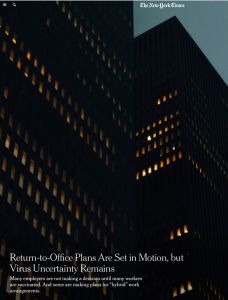Join getAbstract to access the summary!

Join getAbstract to access the summary!
Julie Creswell, Peter Eavis and Gillian Friedman
Return to Office Plans Are Set in Motion, but Virus Uncertainty Remains
Many employers are not making a decision until many workers are vaccinated. And some are making plans for “hybrid” work arrangements.
The New York Times, 2021
What's inside?
Will your company wait until everyone gets vaccinated, stay remote or create a hybrid solution?
Recommendation
With coronavirus vaccination rates rising, most companies plan to return to some semblance of normal, and that means eventually welcoming employees back to the office. But how will they decide when to reopen, how many employees to bring in and how much office time is appropriate? What is the post-pandemic new normal? And what if employees prefer remote work? New York Times business writers Julie Creswell, Peter Eavis and Gillian Friedman examine how a variety of companies are navigating a return to the office and which ones will opt for the emerging hybrid option.
Summary
About the Authors
Julie Creswell, Peter Eavis and Gillian Friedman cover business for The New York Times.




















Comment on this summary